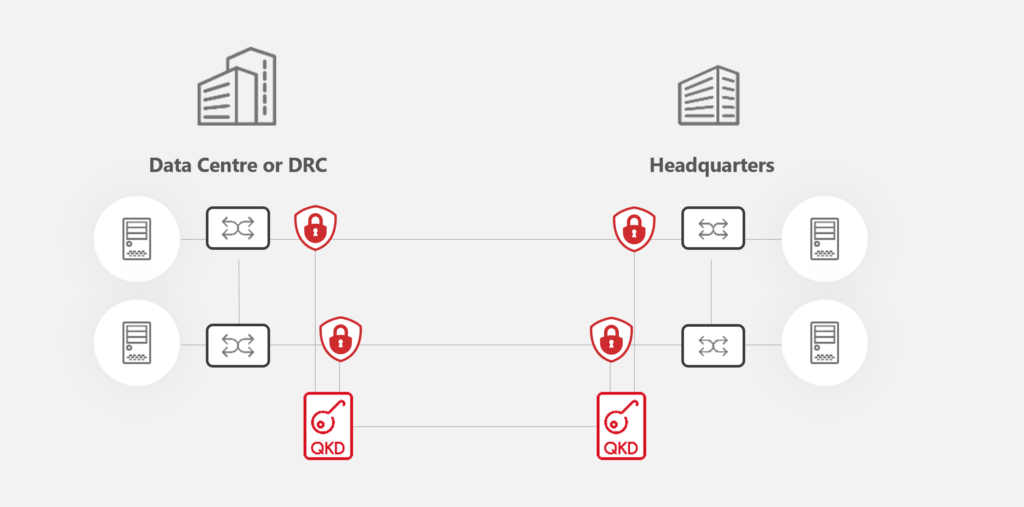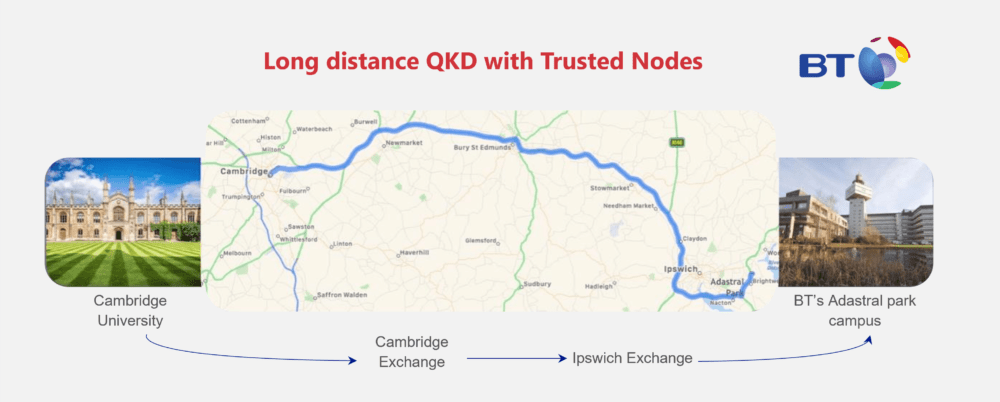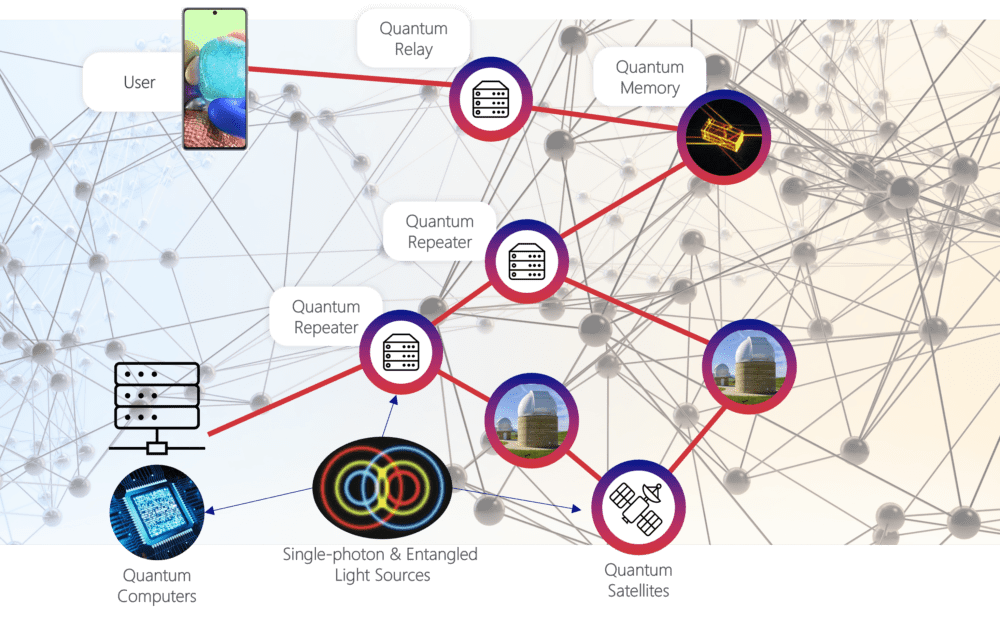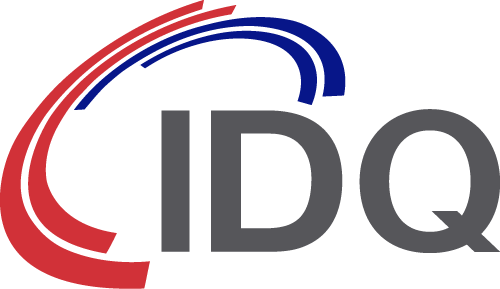From Quantum Networks to the Quantum Internet
There was a time, not all that long ago, when people needed a lot of convincing about the threat posed by the arrival of quantum computing. For the most part, this was because the availability of a viable quantum computer was seen as a far-future thing, almost as science fiction. Just a handful of years ago, promoting quantum technologies, more specifically quantum key distribution (QKD), as a means to counter this invisible threat was quite challenging.
Today, that has all changed. The rapid progress of quantum technologies over the last 10 years has brought the quantum threat into sharp focus. Small-scale quantum computers are already available, and the pivotal moment of quantum supremacy has been and gone. Quantum computing resources are being made available in the cloud, where users can program them remotely and have the results of their computations forwarded to them.
Most experts agree that large-scale quantum computers, those capable of rendering today’s cybersecurity infrastructure useless, will be available by the end of the decade. Fortunately, solutions to counter the emerging threat are already under development. They encompass both new algorithms (classical solutions) and the use of quantum technologies (quantum solutions). The development of a quantum communication infrastructure will not only help secure our communications, but also offer new opportunities.
Let’s dive into the past, present, and future of ultra-secure communications.
Early days: QKD links

In QKD, two distant users (we’ll call them Alice and Bob) exchange quantum objects (qubits) through a quantum channel. With the proper protocol in place, quantum theory (specifically the principle that observation results in perturbation) ensures that any attempt at eavesdropping on the channel results in a modification of the qubits, which will be detected by Alice and Bob. Therefore, QKD offers a secure way to exchange cryptographic keys. However, because qubits cannot be amplified, there are physical limitations on the distances between links. Most commercially available systems have a range of around 100km, but academics had expanded this to several hundred kilometres in test environments.
The first practical implementations of QKD were offered to medium scale companies who needed to secure links between two remote facilities, such as regional data centres. QKD links were only point-to-point and the end-users had to own and operate their system. This limited the early applications of QKD and drove experts to develop solutions that worked over greater distances and with more complex network topologies.
Current architecture: Quantum Networks
Quantum Networks (QN) combine multiple QKD links into a single network. Users located at any node of the QN can ask the network to build end-to-end secure keys. The nodes of the QN, known as Trusted Nodes (TN), combine the secret keys from different QKD links. Reliance on TN is a bit of a liability, but the risks can be mitigated by using tamper-proof hardware and mixing paths to transfer keys.

TN architecture has been implemented by several companies operating small-scale QN to date. However, this is changing. A QN extending over thousands of kilometres, and hundreds of nodes, has been built and is operated in China. A countrywide QN, which will secure government communications, is being built in South Korea, through a collaboration between ID Quantique and SK Broadband. The European Union is planning a Quantum Communication Infrastructure, which will include both ground-based and space-based QKD elements.
With the advent of QN, service providers or operators will be able to deliver new quantum services to end-users; from Key as a Service (KaaS), where end-users get the keys from the QN and apply them to achieve their own security purposes, to Security as a Service (SaaS), where the operator provides an end-to-end security service.
Next Gen Quantum Networks
A major hurdle delaying widespread adoption of QKD is the need for TN. This constraint will be removed by the development of quantum repeaters. The nodes of these new QN will only be relays, which will transfer the qubits without measuring them.
A QN based on quantum repeaters needs two elements. The first is a source of entangled states, the second is a quantum memory that can input, store and output qubits. Entangled sources are already available today. Quantum memories, on the other hand, are still at a development stage. However, they should become a practical reality by the end of the decade.
Quantum repeaters will provide end users with a high level of security, without the need to trust intermediate nodes with the keys. This will represent the ultimate SaaS for demanding end users.
Towards the Quantum Internet

In QN, the quantum layer is only used for the transport of qubits. The end-product provided by the network are classical keys, used for security purposes. The next step is to go to full quantum and keep all the exchanges at the quantum level, including at the end nodes. At this point, the QN will not exchange keys, but rather offer a completely new service: entangled states. This will start at a local or regional level, but should evolve into a completely new network, the Quantum Internet.
Despite the current hype, the applications of the Quantum Internet are not yet well-defined. This should not really come as a surprise, as most applications of the (classical) Internet were also not forecasted. The most likely uses will be cybersecurity related (aforementioned KaaS and SaaS), but it could also be used to enhance the power of quantum computers by networking them. Other intriguing ideas include the development of an earth-scale quantum sensor for astrophysics. It is very likely that new applications will be forthcoming in the next few years.
At ID Quantique, we work with organisations of all types to help them plan for the quantum future. ID Quantique’s Quantum-Safe Security solutions work out-of-the-box with leading network encryption providers & services, making the path to quantum safety simpler than it may seem. Our new high-efficiency detectors will become bricks in the future Quantum Internet.
Watch our CEO’s recent presentation on the topic given at Inside Quantum Technology The Hague 2022:


